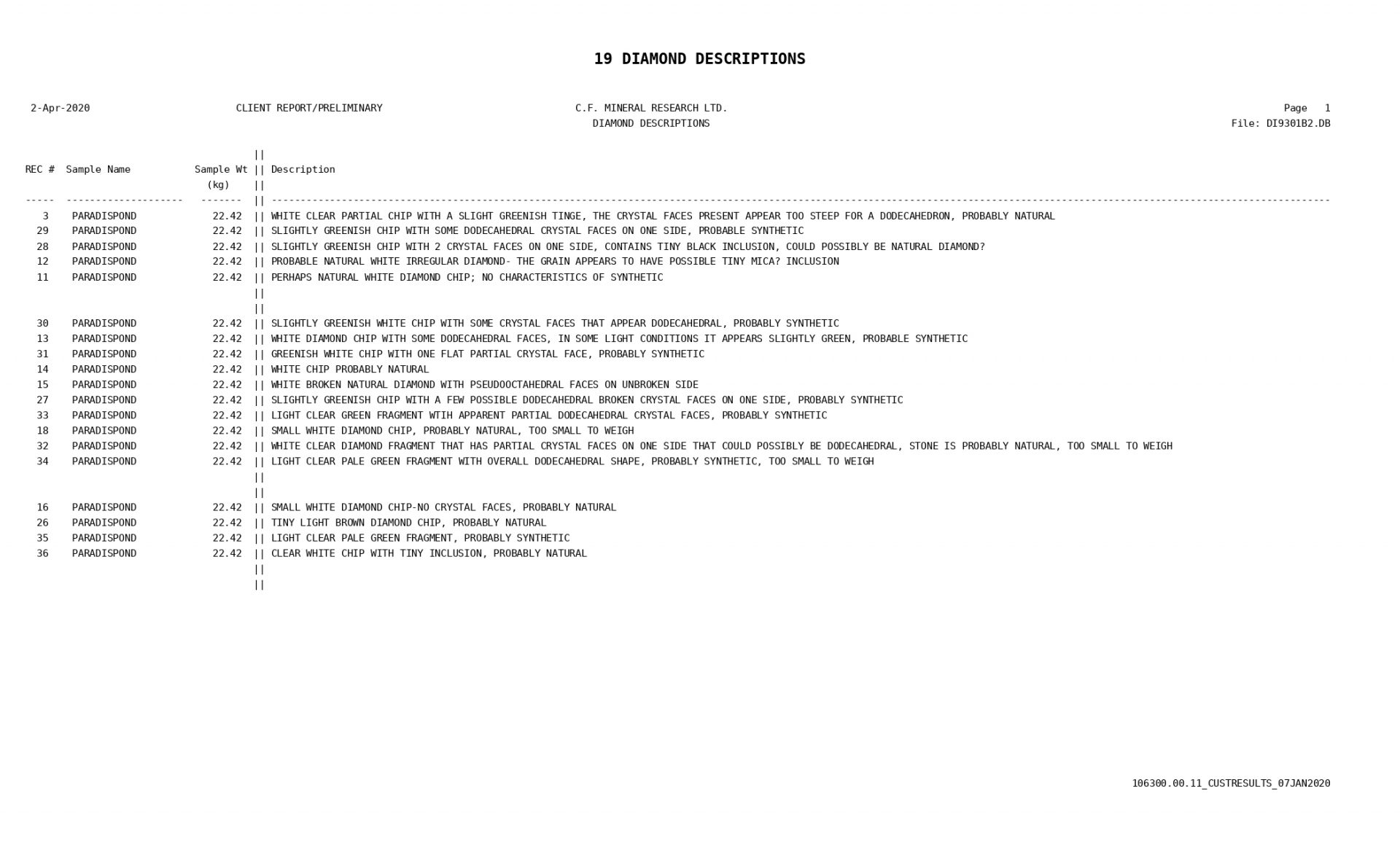Completed by CF Mineral Research Ltd., and Interpreted by Tony Bishop
Summary: EMP Data – Paradis Pond Core
- EMP – Electron microprobe, analyses the various grains of interest in a kimberlite for specific levels of certain elements that match those found in kimberlites and/or found as inclusions in diamonds.
- DSF – geochemical analysis can identify if the KIMs/DIMs were formed in the diamond stability field along with the diamonds.
- In total, 28 grains have properties possibly sourcing from the diamond stability field.
- The Paradis Pond kimberlite and other Bishop targets are located in the Temiskaming Rift Valley system, which continues to the Victor Diamond Mine in Attawapiskat, as well, both are emplaced into the central Archean Superior Craton.
- If the 22.4 kg sample was an accurate representation of the source, the Ilmenite chemistry and other indicator mineral results from Paradis Pond signify the source should have low resorption, meaning diamonds were not burned in transport.
- The detailed analysis of the 18 diamonds discovered by CFM Research in the Paradis Pond drill core contains proprietary and confidential information, and therefore has not been included in this report, but RJK has included one table of Charles E Fipke’s comments on some of the diamonds discovered.
Highlights of the results from 22.4 kg (~50 lbs) of core from Paradis Pond follow:
- Cr – 10 chromites
- Cr Ti – 1 chromite with high titanium – such grains are only derived from kimberlite or lamproite sources
- Cr Si – 1 chromite with high silicon
- Cr04 DI – 1 chromite with diamond inclusion composition, score 4 of 10 (DSF)
- Il-Mn – 4 ilmenites with high manganese, produced during kimberlite emplacement
- Il-Mn D10 – 8 ilmenites of diamond inclusion composition that overlaps with high manganese composition from non-diamond bearing sources
- OP5 – 1 orthopyroxene, Group 5
- OPx – 1 orthopyroxene
- PIl – 10 picroilmenite, (magnesium) Mg-ilmenite, helps determine whether diamonds in the kimberlite were resorbed (burned up) in the kimberlite ascent. The PIl microprobe results (and surface features and texture of the grains) indicate very little resorption in the Paradis kimberlite; therefore, increases the chance of larger diamonds
- CE CP2 – 1 eclogitic clinopyroxene, Group 2
- CE CP4 – 3 eclogitic clinopyroxenes, Group 4
- CE CP6 – 1 eclogitic clinopyroxene, Group 6
- CPx – 1 clinopyroxene
- CE*CP8 – 1 high pressure clinopyroxene of eclogitic paragenesis
- CP CP2 – 11 peridotitic clinopyroxene
- CP CP2 Diam – 1 peridotitic clinopyroxene – diamond well indicated to be stable
- CP CP2 Diam+ – 1 peridotitic clinopyroxene – diamond very well indicated to be stable
- CP CP3 – 1 peridotitic clinopyroxene, Group 3
- CP CP5 – 4 peridotitic clinopyroxene, Group 5
- CP CP5 Gr – 1 peridotitic clinopyroxene – graphite very well indicated to be stable
- CP CPx Diam – 4 peridotitic clinopyroxene – diamond well indicated to be stable
- CP CPx Diam- – 3 peridotitic clinopyroxene – diamond moderately indicated to be stable
- CP CPx G1 – 6 peridotitic clinopyroxene – graphite very well indicated to be stable
- E G3 G2 – 1 eclogitic garnet, non-kimberlitic
- E G3 LPM – 1 eclogitic garnet, probable low pressure, commonly from kimberlitic sources
- E G3 LPM/G2 – 1 eclogitic garnet, could be kimberlitic or non-kimberlitic
- E G5 Reg – 1 eclogitic garnet, probable regional garnet
- E G9 G1/HPM – 1 high pressure megacryst eclogitic garnet in diamond overlap fields
- E G9 HPM – 1 high pressure megacryst eclogitic garnet – commonly from kimberlite and lamproite, but also from other rock types (DSF)
- E G9 HPM* – 2 high pressure megacryst eclogitic garnets (classifies as such in every field)
- E G9 LPM* – 1 low pressure megacryst eclogitic garnet
- P G9 – 3 peridotitic garnets, Group 9
- P G9-1 – 9 peridotitic garnets, Gurney score 1 of 10
- P G10-2 – 12 peridotitic garnets, Gurney score 2 of 10 (DSF)
- P G10-3* – 2 peridotitic garnets, Gurney score 3 of 10 (in diamond stability field) (DSF)
- P G10-4 – 5 peridotitic garnets, Gurney score 5 of 10 (DSF)
- P G10-5* – 2 peridotitic garnets, Gurney score 5 of 10 (in diamond stability field) (DSF)
- P G10-7* – 2 peridotitic garnets, Gurney score 7 of 10 (in diamond stability field) (DSF)
- P G11 – 6 peridotitic garnets
- P G11 D1 – 1 peridotitic garnet (in 9 or 10 of 20 diamond inclusion fields) (DSF)
- P G11-1 – 33 peridotitic garnets, Gurney score 1
- P G11-1 D10 – 2 peridotitic garnets, Gurney score 1 (in 7 or 8 diamond inclusion fields of 20) (DSF)
- R G5 – 2 regional garnets
(Click each chart image to view full screen)
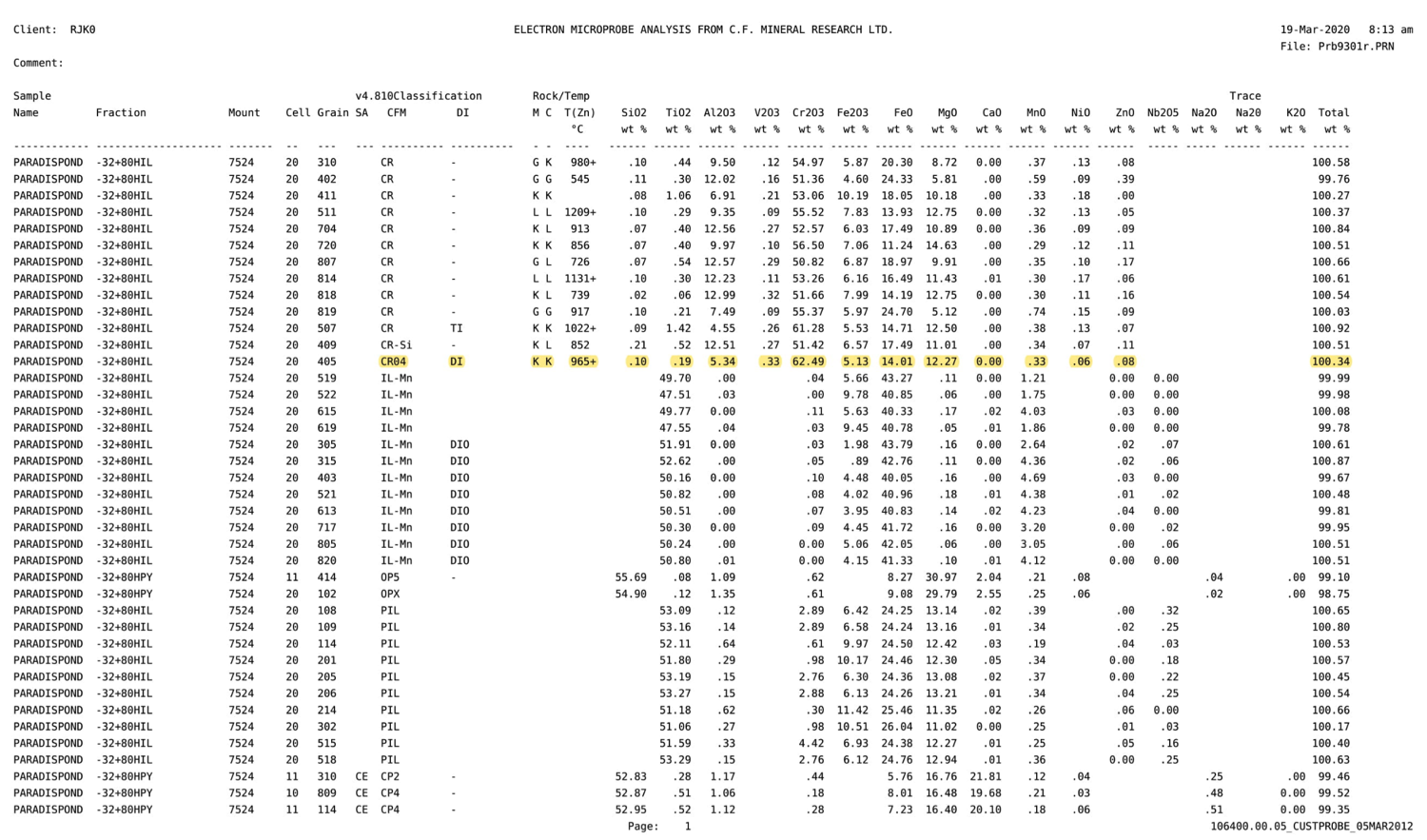
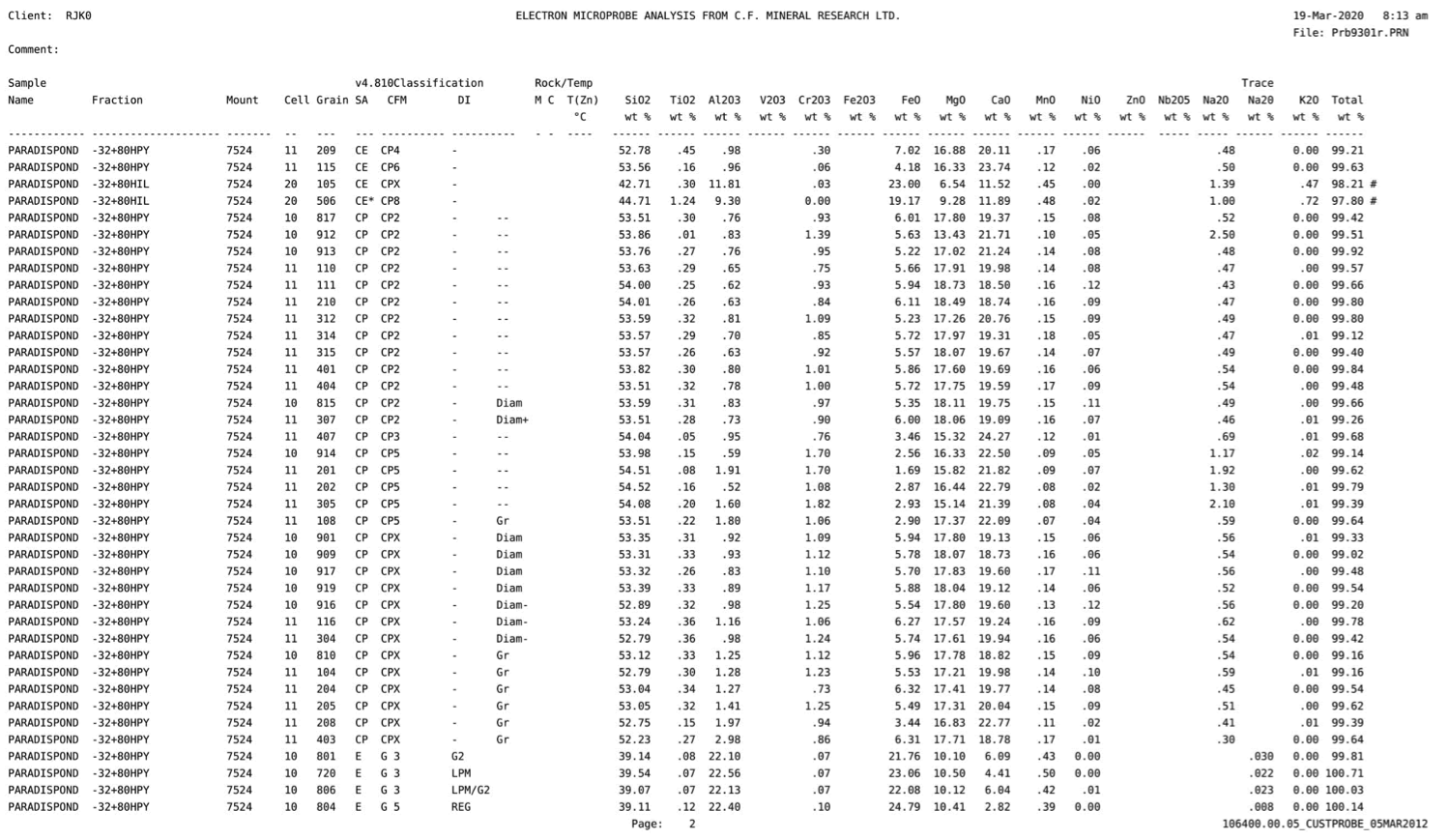
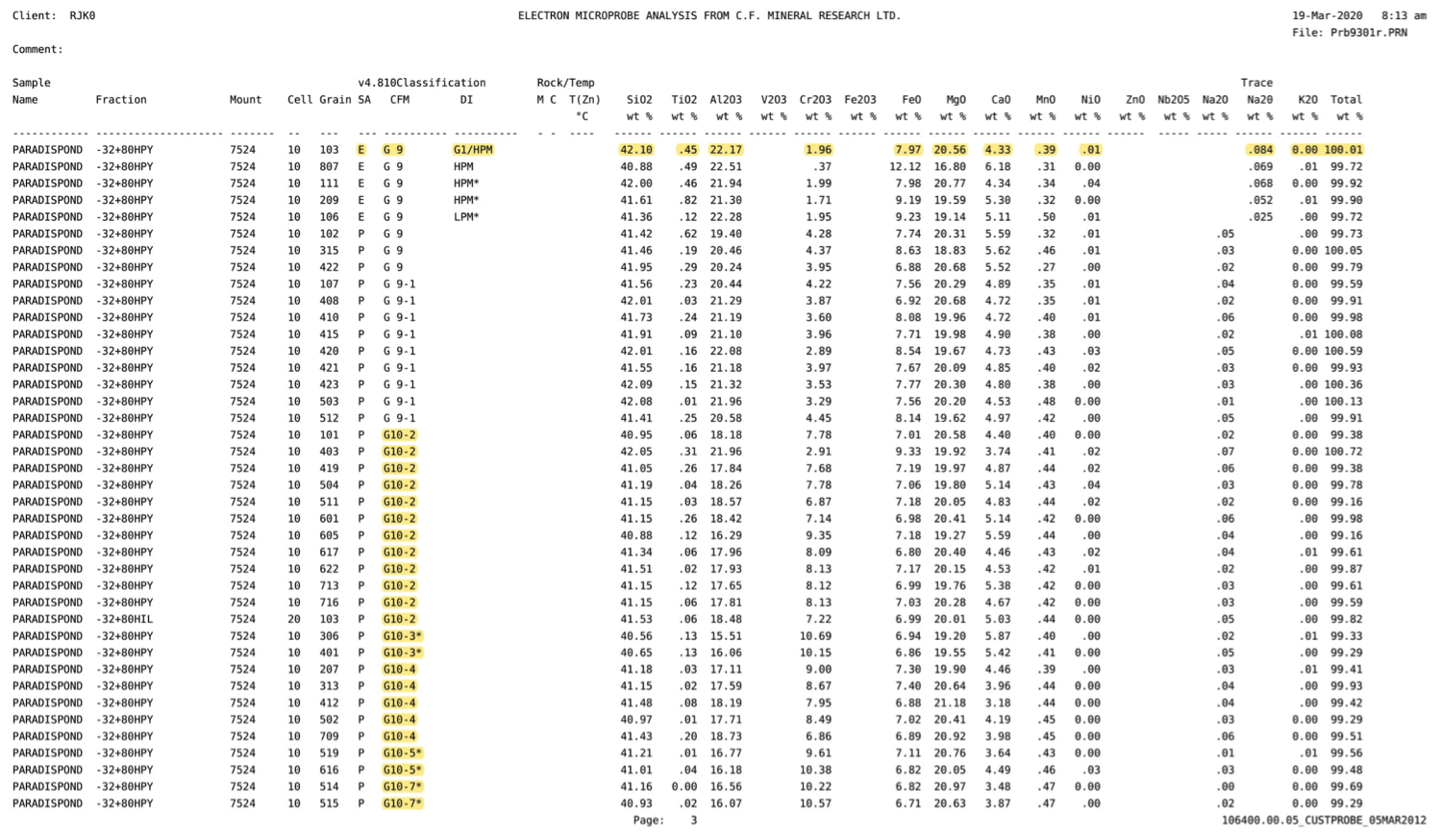
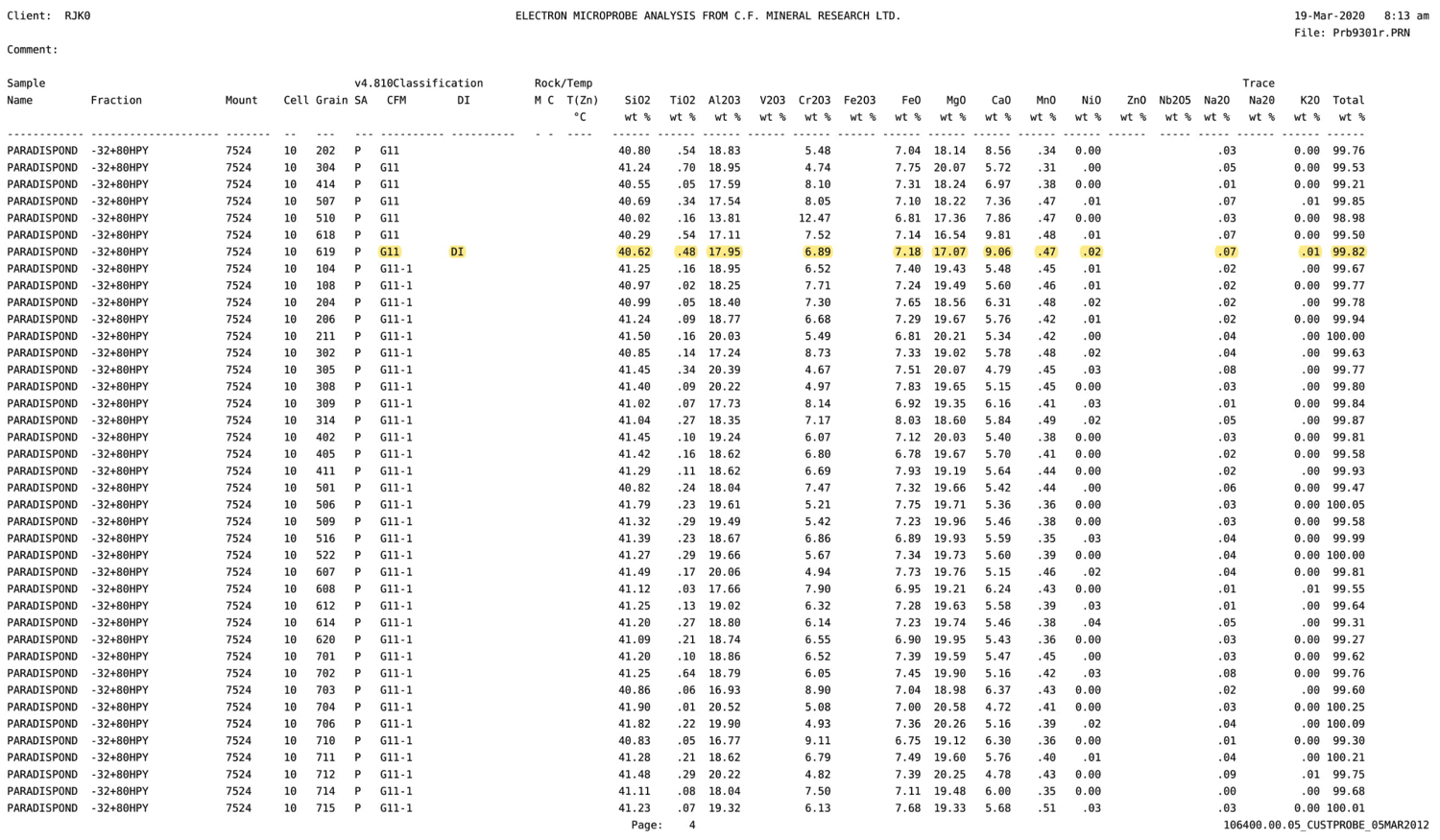

Sample of the Diamond Descriptions from Charles E. Fipke:
